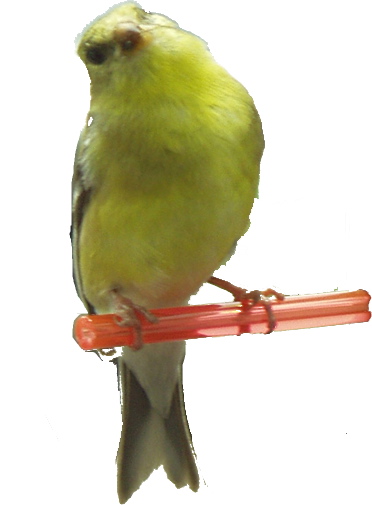-
Really Big nyjer feeder
If wild bird activity in your yard is anything like ours right now, then you likely have tons of Goldfinches. Although they’re not so gold right now with their winter plumage…they’re still out there!
Filling the nyjer feeder for them every few days can really start to become a chore. Some feeders claim to be large capacity feeders – but really aren’t. This one is definitely a large capacity feeder, holding seven pounds of nyjer seed (more commonly called thistle).
Now seven pounds may not sound like much when thinking of volume, but thistle is a tiny grain-like seed, and seven pounds in a feeder is a lot.
Pine Siskins and Red Polls also visit nyjer feeders, and our Goldfinches are even eating suet in this frigid weather.
Help birds thrive during cold weather by offering a few staples that will serve them well in winter. Thistle, suet and sunflower seed are a few good options.
Water is also extremely important, especially when birds’ usual sources (like shallow ponds) tend to freeze. A heater in your birdbath will also be a welcome sign to entice many feathered friends. Happy Birding!
-
Upside Down finch feeders are Selective
Got House Finches? Got Purple Finches? Want a feeder for Goldfinches only? Then you’ve got to try upside down finch feeders. That’s exactly why they make them…for Goldfinches only. They are the only finches (in North America) who will eat while perched upside down.
Goldfinches’ electric yellow plumage has earned them the nickname “wild canary”. And although their plumage does fade in winter to an olive-drab color, continue feeding them throughout the year to have that bright yellow color grace your yard in spring and summer.
Finch feeders are a perfect choice for yards and gardens as the thistle (or nyjer) seed is a non-germinating seed. This means no weeds below feeders. It’s a pleasure to watch these sweet birds as well, as feeding habits are more likely to have them stick around pecking seed after seed, as opposed to grabbing a seed and flying off with it.
All finches, plus other birds will use finch feeders filled with thistle seed. If you’re wanting to be more selective and attract American Goldfinches only, go for an upside down finch feeder this year. Happy Birding!
-
Want more birds at your nyjer feeder?
There are no set rules in wild bird feeding, we offer birds different varieties of food that entice them and keep them coming back. Of course habitat plays a huge role, with places for shelter and nesting like mature trees, thickets and shrubs. The all important water source is also a big factor for attracting feathered friends.
Just because finches eat thistle, or nyjer seed, doesn’t mean they wont’ frequent other feeders offering different seed mixes. For the last few days, I’ve been seeing Black Capped Chickadees at the nyjer feeder. Now maybe it’s just the time of year, but I’ve never seen them at this feeder before. Also, the juvenile Eastern Bluebirds, who will eat suet during our cold winter months, have already started feeding at the suet feeder too.
A favorite treat for several birds is to mix thistle seed with finely chopped sunflower hearts. Placing this seed mix in the nyjer feeder attracts Juncos, Pine Siskins, Towhees and House and Purple Finches, as well as the Goldfinch.
In early spring, try offering nesting materials and encourage birds to take up residence by nesting in your yard. Collect dryer lint, pet hair, cotton yarns and fibers, and decorative mosses to create a nest ball with variety of materials that birds prefer. You can place them in a standard suet cage, or mesh produce bag from the grocery store. Of course commercial materials are available, and even some cool holders to accommodate them.
Just because the bright yellow feathers disappear in fall, it doesn’t mean these birds are gone. Remember to keep nyjer feeders out year round with fresh seed, as goldfinches and others will stick around during during winter months.





